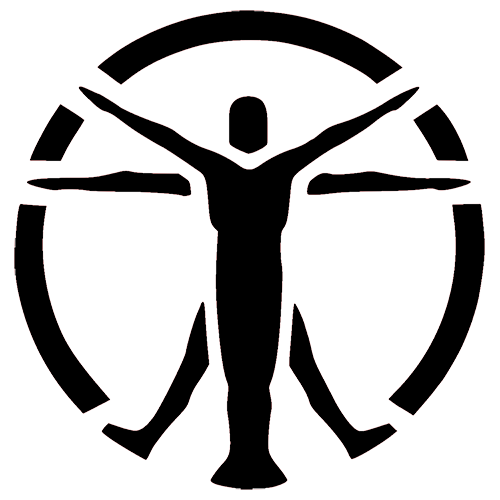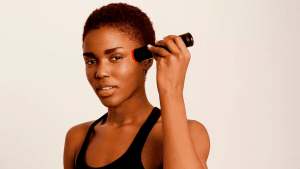Stretch marks laser removal is a comfortable, painless, and the most effective procedure today. Stretch marks are irreversible, and it is difficult to get rid of them completely. However, modern treatment methods make scars almost invisible. It helps thicken the skin, stimulate collagen production, and accelerate its regeneration. The stretch mark laser removal combats stretch marks caused by hormonal imbalance, sudden weight fluctuations, pregnancy, or taking steroid medications.
In this article, we have reviewed what types of lasers exist today and which stretch mark types they do work best. All this information is supported by before and after photos of the laser removal procedure.
Stretch mark laser removal: before and after
The aesthetic problem of stretch marks is that they are pronounced against the background of healthy skin. Only appeared on the skin stretch marks, as a rule, have dark or pinkish shades, but after some time, their color changes to white-pink.
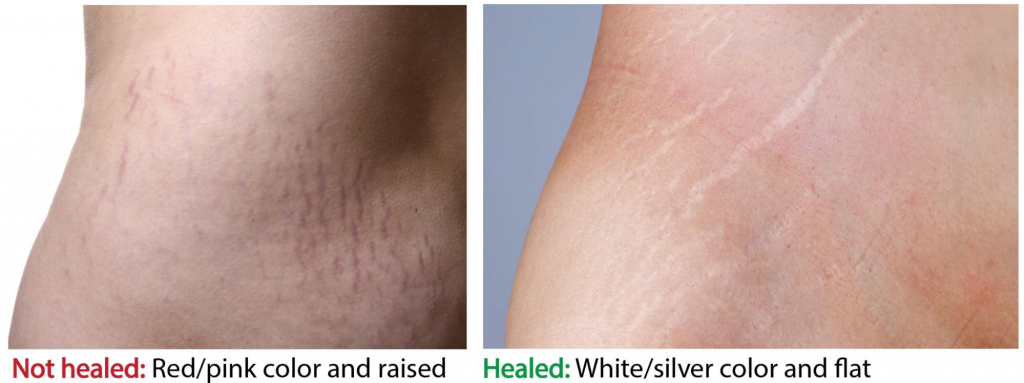
The laser beams affect the upper layers of the epidermis. Water from the cells evaporates, the damaged areas destroy, skin metabolic processes improve, and then the skin actively regenerates. As a result, after laser removal of stretch marks, scars and wrinkles disappear, and the skin looks smooth, younger, and well-groomed.

After exposure to the laser treatment, the skin begins actively producing new collagen and elastin. It makes the skin denser and firmer, so the width and length of the stretch marks are noticeably reduced, and minor stretch marks disappear altogether.
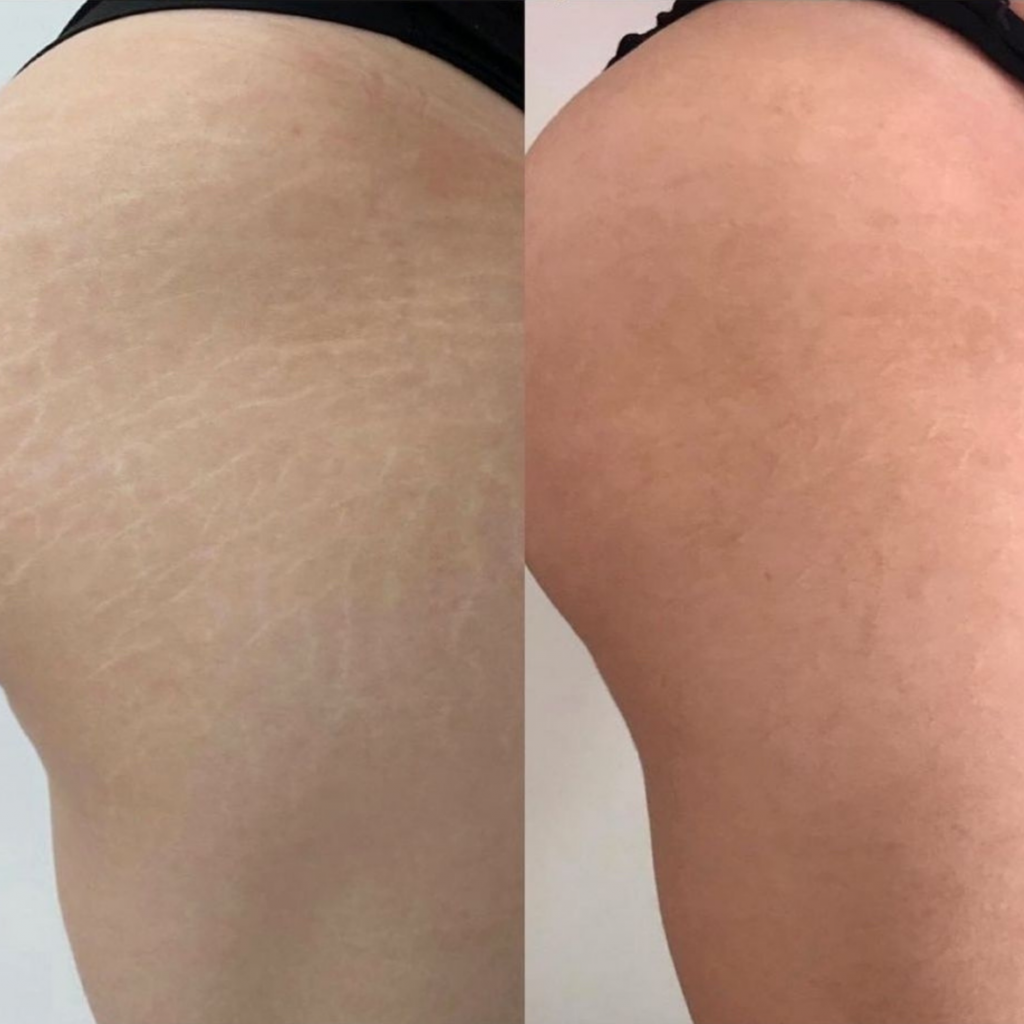
The effectiveness of laser stretch mark removal is lower when applied to long-standing stretch marks — you can not get rid of them completely. Due to the procedure, such stretch marks can be made less noticeable, smooth, and uniform in color. But traces after such lesions will remain.

Pros
- It is a non-invasive procedure.
- Ability to correct stretch marks on all parts of the body, including thin, sensitive skin.
- Eliminate both newly formed and old stretch marks.
- The visible effect after the first session.
- Minimal traumatic consequence and low painfulness of the procedure.
- Long-term results.
Cons
- It is an expensive procedure.
- Some side effects can occur, such as itching, peeling, and redness.
- A long recovery period and, therefore, a long period of treatment.
Like any cosmetic procedure, stretch mark laser removal also has several contraindications:
- Pregnancy, lactation.
- Systemic connective tissue diseases.
- Varicose veins in the area with stretch marks.
- Acute inflammatory processes in the affected area.
- Cancer.
What types of laser removal to choose?
There are two main categories of lasers used in the treatment of stretch marks: ablative and non-ablative.
Ablative lasers remove areas of tissue that are exposed to radiation. When the ablative laser is applied to the skin, intense but brief laser pulses heat the water contained in the skin surface layers(epidermis). It causes the water and, with it, the epidermal cells to vaporize. Every time the laser beam passes over the skin surface, it destroys some amount of epidermal cells at a strictly controlled depth.
📌There are two main ablative laser types: carbon dioxide (CO2) and Erbium (Er: YAG).
Non-ablative lasers affect the skin without killing the cells — they stimulate various metabolic processes. Lasers of this type operate with a lower level of light energy, so their effect causes less damage to the skin than ablative The main effect of laser beams is realized in the deep dermal layer of the skin, while the epidermis remains untouched. It reduces recovery time after laser skin resurfacing procedures and reduces the number of possible complications.
📌Non-ablative laser types include Pulsed Dye, Excimer, and Nd: YAG (Neodymium).
Fractional CO2 Laser for all types of stretch marks
It is the latest effective method of laser removal of stretch marks of varying complexity and origin, which involves a selective (fractional) impact on the skin.
A beam of laser beams produces a large number of small layer-by-layer thermal lesions in the skin, which actives the synthesis process of new elastic and collagen fibers. There is tissue formation with good elasticity in place of the damaged fiber. The skin relief smoothes, and stretch marks eliminate. Rapid healing and regeneration of the skin tissue take place.
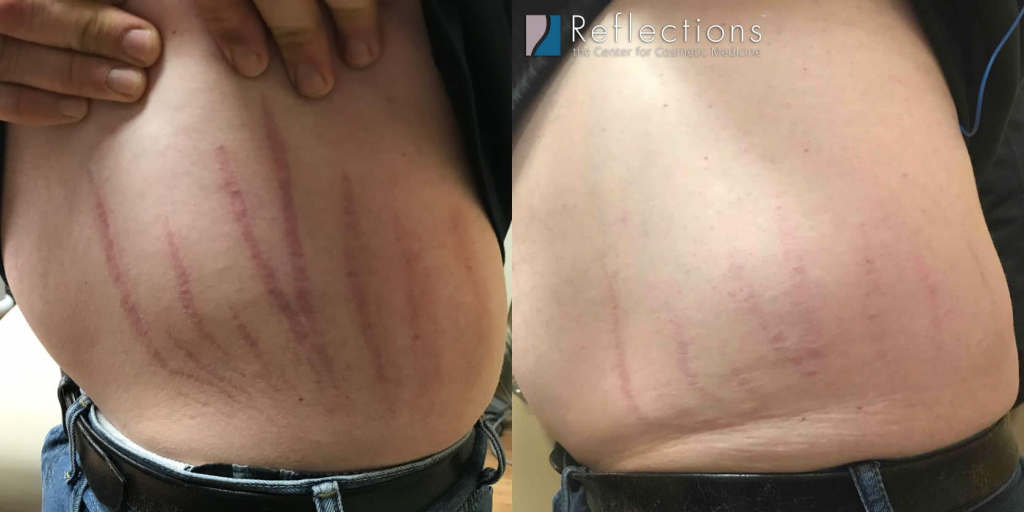
Pulsed Dye Laser for red stretch marks
This laser therapy type is currently considered the most effective method for red scars and stretch marks corrections.
The red (pink, purple) color of some stretch marks is due to the blood vessels located close to the skin surface in the stretch mark area. Studies [1] have found that certain types of laser radiation can destroy blood vessels or cells that produce melanin and therefore change the red color of stretch marks to a more similar to the ordinary color of the skin.
During the procedure, the laser beam penetrates deep into the skin and, affecting the deeper layers, activates the production of collagen, which replaces the connective tissue of stretch marks. As a result, stretch marks disappear or are significantly reduced.

Excimer Laser for old stretch marks
For laser removal of stretch marks formed more than a year ago, experts advise using this device type.
The intense ultraviolet beam produced by the laser removal affects the stretch marks by destroying the connective tissue cells. After the procedure, a crust is formed on the skin, which disappears in a few days. Under it is the process of healing new tissue.
Excimer laser activates the synthesis of melatonin, which is responsible for skin color, so stretch marks take on a healthy skin tone.
Laser removal of stretch marks with this device type guarantees excellent results since, instead of cutting or burning, the bonds between the molecules in the affected area are broken down. Because of this, a healthy epidermis is formed as quickly as possible.
But this method of laser removal of stretch marks has one contraindication. The procedure is prohibited for people suffering from photodermatosis (allergy to ultraviolet light).

Nd: YAG Laser for white stretch marks
Neodymium laser combines high efficiency and safety. The neodymium laser principle is based on the fact that the laser beam affects the tissue directly from the inside without compromising the healthy skin integrity. Neodymium laser is considered the safest — it is difficult to burn the skin using such a device, adhering to the technology of the procedure.
The best effects of the neodymium laser can be achieved when treating fresh pink or red stretch marks. And neodymium laser can reduce old, white striae to barely noticeable with this method.
This method is also called “laser heating” because it is based on warming human biological tissues to a certain depth with a neodymium laser. Influencing the deep layers of the dermis by systematically heating them to a temperature of 65-70 degrees, the neodymium laser provokes the stimulation of collagen fibers, which accelerate the process of tissue healing, smooth the skin microrelief, and make it elastic and firm.

Er: YAG Laser for recent red and pregnancy stretch marks
The laser removal of stretch marks after delivery performs with an erbium laser. This procedure is delicate and safe because the rays penetrate only 1-5 microns into the epidermis.
The getting rid of dead cells process proceeds so quickly that the surrounding skin areas are not heated, which is why the Erbium laser is called “cold.”
Its effect on the problem areas of the skin is more gentle than that of CO2 laser treatment and more effective compared to the latest generation of laser type — neodymium.

Is laser stretch mark removal effective on dark skin?
It used to be thought that laser treatment is ineffective for dark skin, hurts skin, and leaves hyperpigmentation. But nowadays, with modern laser technology, there is nothing to be afraid of. Not only is the laser removal treatment safe for dark skin, but it is just as effective as it is for light skin. The most suitable laser type for this procedure is the neodymium laser. Its long-wave radiation does not penetrate deeply into the skin, is poorly absorbed by melanin, and therefore is not well taken up by skin cells without damaging them.

Does it hurt?
Laser removal of stretch marks does not cause severe pain, only slight discomfort. Some doctors recommend to their patients, especially those with sensitive skin, to put an anesthetic cream on the area where the removal will take place one hour before the procedure. However, this is not necessary. Without them, it is perfectly safe to perform the treatment.
During the procedure, you can feel a slight tingling sensation on the skin, which does not cause much discomfort. If you s a lot of pain, you should tell your doctor so that he can turn down the power to a more comfortable level for you.
After the procedure, the treatment site may become red and slightly inflamed. In this case, panthenol and cold lotions can help. If the pain makes you very uncomfortable, it is better to consult your doctor.
How much does laser stretch mark removal cost?

There is no one constant price for laser stretch mark removal. The cost depends on the area to be treated, the time spent on the procedure, and which laser technology is used. It also depends on how your skin reacts to the treatment – it may be faster or longer, depending on your circumstances. For example, older stretch marks require more treatments than new ones.
According to the American Board of Cosmetic Surgery (ABCS), prices range from $1,980 to $3,170.
Summary
Stretch marks are marks or scars that remain on the skin after too much stretching. They occur after pregnancy or if a person rapidly gains and loses weight. In adolescents, stretch marks sometimes appear during a period of intense growth. It can also be a consequence of hormonal disorders in the body or is the result of prolonged use of steroids.
They are not dangerous to health but can cause aesthetic discomfort. Unfortunately, stretch marks are difficult to treat with local remedies (gels, ointments, massages, etc.) The only effective way to get rid of them — is laser stretch mark removal.
Removing stretch marks with laser treatment allows you to remove them permanently or visibly improve their appearance. Resurfacing partially removes the top layers of the skin along with the stretch marks.
The impact of the stretch mark laser removal is gentle and the skin recovery is faster under the influence of the rays of the destroyed scar tissue and stimulates the regeneration of healthy skin due to the intense production of collagen and elastin.
FAQ
⌛Can laser remove stretch marks permanently?
Like any scar, it is almost impossible to remove stretch marks permanently. The affected skin, permeated with areas of connective tissue, will never return to its original state. But with the help of laser treatment, you can significantly improve their appearance and make them almost invisible. And with proper care, the effect is long-lasting.
⏲How long does it take to remove stretch marks with a laser?
A pronounced effect can be seen immediately after the first treatment, but if you have a lot of stretch marks that appeared a long time ago, you should take a course of procedures. The amount and frequency of laser sessions are determined by your cosmetologist. On average, 4-5 treatments with a couple of weeks between each.
💬Does laser scar removal work on stretch marks?
The only effective method of removing stretch marks is laser therapy. After the first session of removing stretch marks in the abdomen and other areas, you notice how relatively fresh scars become lighter, and the older ones begin to smooth out. Thermal radiation stimulates microcirculation in the tissues and the synthesis of epidermal proteins. It leads to the resorption of fibrous fibers and the disappearance of stretch marks.
🦕Can old stretch marks be removed?
Laser removal of old stretch marks on the abdomen and other body parts is the most effective, fast, and painless method of solving the problem.
🩹Are there any side effects of laser treatment for stretch marks?
The laser removal is completely safe because it only penetrates the upper layers of the skin. After the procedure, the treatment site may become red and slightly inflamed. In this case, panthenol and cold lotions can help.
⌚How many laser sessions are needed for stretch marks?
Typically, treatment lasts – 4-5 months (4-5 treatments at intervals of 3-4 weeks). If the stretch marks are minor (up to 0.3 cm) — one session is enough. One session can reduce the width of the stretch marks by 20%.
Sources
D H McDaniel, K Ash, M Zukowski. Treatment of stretch marks with the 585-nm flashlamp-pumped pulsed dye laser. Dermatolog Surg. 1996 Apr;22(4):332-7. doi: 10.1111/j.1524-4725.1996.tb00326.x.
